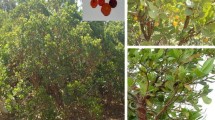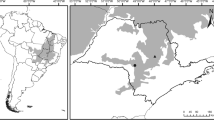Abstract
We describe the population ecology of two tropical deciduous trees, Bombax ceiba leiocarpum A. Robyns and Brachychiton diversifolius R. Br., which are in high demand for Indigenous sculpture production in Arnhem Land, Australia. We monitored tagged populations of both species at two locations for 2 years to examine their reproduction, growth, and survival rates and their response to harvest. Both species have similar life histories: they reproduce during the dry season (June–November) producing a high seed load, seed predation was high, seeds did not survive in the soil past the following wet season to form a seed bank, and germination rates were low and variable for both species. Average annual circumference growth rates were 1.07 cm year−1 for B. ceiba and 0.98 cm year−1 for B. diversifolius, with most of the growth occurring during the early wet season. Most (65–88 %) of the harvested B. ceiba and B. diversifolius stems coppiced. Coppice and stem size class were the main factors influencing tree growth rates with coppice stems growing up to six times faster than similar sized non-coppice stems. The survival of B. ceiba and B. diversifolius stems was size class dependent and affected by local site factors (e.g. fire and other disturbances) so that the smaller size classes had a low probability of survival. Given the resprouting potential of both species, their wild harvest is likely to have only minimal local impact on wild populations. However, further population modelling is required to determine whether the small and disjunct B. ceiba populations can sustain harvesting at current levels.




Similar content being viewed by others
References
Altman J, Taylor L (1989) The economic viability of Aboriginal outstations and homelands: a report to the Australian Council for Employment and Training. Australian National University, Canberra
Bach C (2002) Phenological patterns in monsoon rainforests in the Northern Territory, Australia. Austral Ecology 27:477–489
Baker T, Affum-Baffoe K, Burslem D, Swaine M (2002) Phenological differences in tree water use and the timing of tropical forest inventories: conclusions from patterns of dry season diameter change. Forest Ecology and Management 171:261–274
Bowman DMJS, Panton WJ (1993) Factors that control monsoon-rainforest seedling establishment and growth in north Australian Eucalyptus savanna. Journal of Ecology 81:297–304
Brock J (2001) Native plants of northern Australia. Reed New Holland, Sydney
Buckley Y, Briese D, Rees M (2003) Demography and management of the invasive plant species Hypericum perforatum. I. Using multi-level mixed-effects models for characterising growth, survival and fecundity in a long-term data set. Journal of Applied Ecology 40:481–493
Buist M, Yates CJ, Ladd PG (2000) Ecological characteristics of Brachychiton populneus (Sterculiaceae) (kurrajong) in relation to the invasion of urban bushland in south-western Australia. Austral Ecology 25:487–496
Bureau of Meteorology (2011) Australian Bureau of Meteorology. www.bom.gov.au. Accessed 19 May 2011
Burnham K, Anderson D (1998) Model selection and multimodel inference: a practical information-theoretic approach. Springer-Verlag, New York
Burnham K, Anderson D (2001) Kullback-Leibler information as a basis for strong inference in ecological studies. Wildlife Research 28:111–119
Chibnik M (2003) Crafting tradition: the making and marketing of Oaxacan wood carvings. University of Texas Press, Austin
Choquenot D (1996) The ecological basis of wildlife harvesting. In: Bomford M, Caughley J (eds) Sustainable use of wildlife by Indigenous Peoples and Torres Strait Islanders. Australian Government Publishing Service, Canberra, pp 48–59
Crawley M (2002) Statistical computing: an introduction to data analysis using S-Plus. John Wiley and Sons Ltd, UK
Cunningham AB, Choge SK (2004) Crafts and conservation: the ecological footprint of international markets on an African resource. Advances in Economic Botany 15:215–234
Denham A, Auld T (2002) Flowering, seed dispersal, seed predation and seedling recruitment in two pyrogenic flowering resprouters. Australian Journal of Botany 50:545–557
Fox R, Clark N (1972) The incidence of termites in eucalypts of the Darwin area. Australian Forest Research 5:29–36
Freckleton R, Matos D, Bovi M (2003) Predicting the impacts of harvesting using structured population models: the importance of density dependence and timing of harvest for a tropical palm tree. Journal of Applied Ecology 40:846–858
Griffiths AD, Philips A, Godjuwa C (2003) Harvest of Bombax ceiba for the Aboriginal arts industry, central Arnhem Land, Australia. Biological Conservation 113:295–305
Griffiths AD, Schult J, Gorman J (2005) Wild harvest of Cycas arnhemica (Cycadaceae): impact on survival, recruitment and growth in Arnhem Land, northern Australia. Australian Journal of Botany 53:771–779
Guariguata MR, Pinard MA (1998) Ecological knowledge of regeneration from seed in neotropical forest trees: implications for natural forest management. Forest Ecology and Management 112:87–99
Guinto DF, House A, Hong Xu Z, Saffigna P (1999) Impacts of repeated fuel reduction burning on tree growth, mortality and recruitment in mixed eucalypt forests of southeast Queensland, Australia. Forest Ecology and Management 115:13–27
Koenig J (2007) “Too many trees!” Indigenous woodcarving and harvest sustainability in central Arnhem Land. Unpublished PhD thesis, Charles Darwin University, Australia
Koenig J, Altman JC, Griffiths AD (2011a) Artists as harvesters: natural resource use by indigenous woodcarvers in central Arnhem Land, Australia. Human Ecology 39:407–419
Koenig J, Altman JC, Griffiths AD (2011b) Indigenous livelihoods and art income: participation, production and returns from woodcarvings in Arnhem land, north Australia. Australian Geographer 42(4):351–369
Lobo J, Quesada M, Stoner K, Fuchs E, Herrerias-Diego Y, Rojas J, Saborio G (2003) Factors affecting phenological patterns of Bombacaceous trees in seasonal forests in Costa Rica and Mexico. American Journal of Botany 90:1054–1063
Lugoa E, Witkowski E, Balkwill K (2004) Regeneration by coppicing (resprouting) of miombo (African savanna) trees in relation to land use. Forest Ecology and Management 189:23–35
McLaren K, McDonald M (2003) Coppice regrowth in a disturbed tropical dry limestone forest in Jamaica. Forest Ecology and Management 180:99–111
Miller PM (1999) Coppice shoot and foliar crown growth after disturbance of a tropical deciduous forest in Mexico. Forest Ecology and Management 116:163–173
Negreros-Castillo P, Hall RB (2000) Sprouting capability of 17 tropical tree species after overstory removal in Quintana Roo, Mexico. Forest Ecology and Management 126:399–403
Nzunda EF, Griffiths ME, Lawes MJ (2007) Multi-stemmed trees in subtropical coastal dune forest: survival strategy in response to chronic disturbance. Journal of Vegetation Science 18:693–700
Nzunda EF, Griffiths ME, Lawes MJ (2008) Sprouting by remobilization of above-ground resources ensures persistence after disturbance of coastal dune forest trees. Functional Ecology 22:577–582
Olmstead I, Alvarez-Buylla E (1995) Sustainable harvesting of tropical trees: demography and matrix models of two palm species in Mexico. Ecological Applications 5:484–500
Ooi M, Auld T, Whelan R (2004) Comparison of the cut and tetrazolium tests for assessing seed viability: a study using Australian native Leucopogon species. Ecological Management and Restoration 5:141–143
Prior L, Eamus D, Bowman D (2004) Tree growth rates in north Australian savanna habitats: seasonal patterns and correlations with leaf attributes. Australian Journal of Botany 52:303–314
R Development Core Team (2009) R: a language and environment for statistical computing. R Foundation for Statistical Computing, Vienna
Russell-Smith J (1992) Plant populations and monsoon rain forest in the Northern Territory, Australia. Biotropica 24:471–487
Russell-Smith J, Lucas DE (1994) Regeneration of monsoon rain forest in northern Australia: the dormant seed bank. Journal of Vegetation Science 5:161–168
Setterfield S (2002) Seedling establishment in an Australian tropical savanna: effects of seed supply, soil disturbance and fire. Journal of Applied Ecology 39:949–959
Setterfield S, Williams R (1996) Patterns of flowering and seed production in Eucalyptus miniata and E. tetrodonta in a tropical savanna woodland, northern Australia. Australian Journal of Botany 44:107–122
Shackleton C (2001) Managing the regrowth of an indigenous savanna tree species (Terminalia sericea) for fuelwood: the influence of stump dimensions and post-harvest coppice pruning. Biomass and Bioenergy 20:261–270
Soehartono T, Newton A (2001) Conservation and sustainable use of tropical trees in the genus Aquilaria II. The impact of gaharu harvesting in Indonesia. Biological Conservation 97:29–41
Ticktin T (2004) The ecological implications of harvesting non-timber forest products. Journal of Applied Ecology 41:11–21
Ticktin T, Nantel P, Ramirez F, Johns T (2001) Effects of variation on harvest limits for non-timber forest species in Mexico. Conservation Biology 16:691–705
Williams R, Myers B, Eamus D, Duff G (1999) Reproductive phenology of woody species in a north Australian tropical savanna. Biotropica 31:626–636
Woinarski JCZ, Mackey B, Nix H, Trail B (2007) The nature of northern Australia. ANU E Press, Canberra
Worbes M (1995) How to measure growth dynamics in tropical trees. IAWA Journal 16(4):337–351
Wright F (1999) The art and craft centre story. Volume 1 report: a survey of 39 Aboriginal community art and craft centres in remote Australia. Aboriginal and Torres Strait Islander Commission, Canberra
Acknowledgments
All fieldwork in the Maningrida region was carried out with the Djelk Rangers, particularly Clint Millingkan, Stuart Ankin, Matthew Marrday and Charles Godjuwa. We thank the Bawinanga Aboriginal Corporation and staff at Maningrida Arts and Culture for support and the Traditional Owners who granted permission for us to work on their land. JB Fisher, Francis Garwun, Derek Carter, Terry Ngamandarra, Audrey Hill, Julia Schult, Tanya and Scott Parker, and Leo Price also provided invaluable field assistance. The permanent plots were established at Gunn Point with the permission of the Parks and Wildlife Service of the Northern Territory and the Northern Territory Land Corporation. We thank Lynda Prior and three anonymous reviewers for comments on the manuscript. This study was funded by an Australian Research Council Linkage grant and an Australian Federation of University Women (Queensland) scholarship.
Author information
Authors and Affiliations
Corresponding author
Rights and permissions
About this article
Cite this article
Koenig, J., Griffiths, A. The Population Ecology of Two Tropical Trees, Brachychiton diversifolius (Malvaceae) and Bombax ceiba (Bombaceae), Harvested by Indigenous Woodcarvers in Arnhem Land, Australia. Environmental Management 50, 555–565 (2012). https://doi.org/10.1007/s00267-012-9911-9
Received:
Accepted:
Published:
Issue Date:
DOI: https://doi.org/10.1007/s00267-012-9911-9




